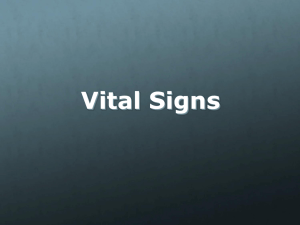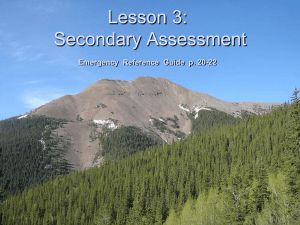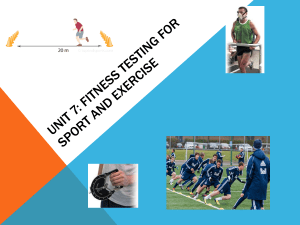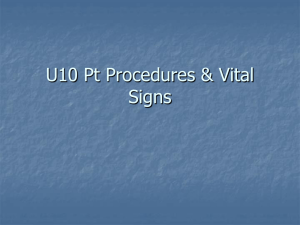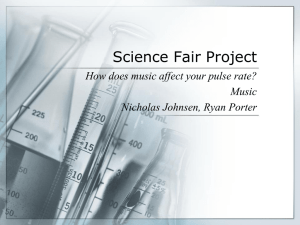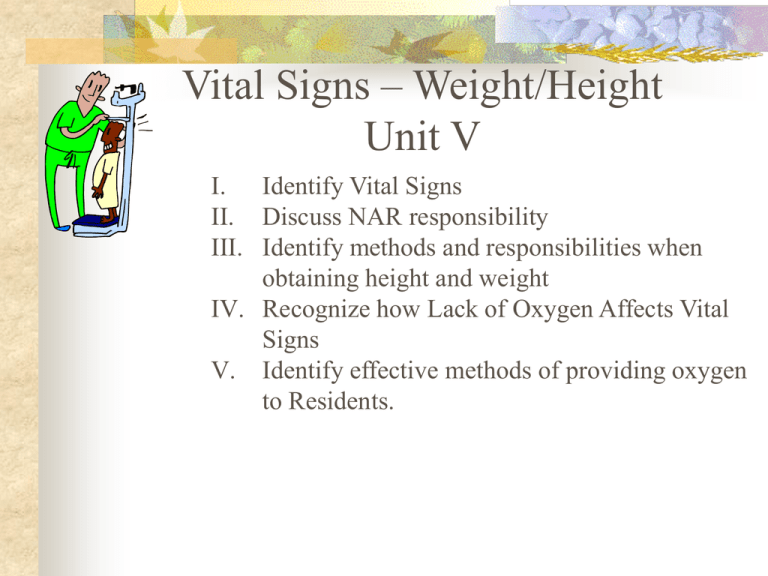
Vital Signs – Weight/Height
Unit V
I. Identify Vital Signs
II. Discuss NAR responsibility
III. Identify methods and responsibilities when
obtaining height and weight
IV. Recognize how Lack of Oxygen Affects Vital
Signs
V. Identify effective methods of providing oxygen
to Residents.
Vital Sign Skills
Oxygen tubing safety
Temperature with a glass thermometer
Temperature with an electronic
thermometer
Pulse and Respiration
Blood Pressure
Height and weight measurements
Key Terms
Temperature - Measurement of body heat.
Fever -
Elevated temperature; usually a sign of illness.
Pulse -
Expansion and contraction of an artery.
Pulse Rate -
Measures heart beats; the number of times the heart
beats per minute
Pulse Spots - Areas on body where pulse can be counted or
measured.
Respirations – The process of breathing; the exchange of gases
(oxygen and carbon dioxide) in the lungs.
Blood Pressure –
Measurement of the force of the blood against
the walls of the arteries.
Systolic Pressure - Number at which the first sound is heard or
highest number when the blood pressure is
measured.
Diastolic Pressure - Number at which the last sound is heard or
lowest number when blood pressure is
measured.
Hypertension -
High blood pressure; greater than 140/90.
Hypotension -
Low blood pressure; lower than 90/50.
TPR -
Abbreviation for temperature, pulse and
respiration.
VS -
Abbreviation for vital signs which are
temperature, pulse, respiration and blood
pressure.
I.
Describe Vital Signs
A. Define Vital Signs
1. Measurement of the functioning of vital (necessary for
life) organs of the body: heart, lungs and blood vessels.
2. The resident’s condition can be monitored by vital
signs; temperature, pulse, respiration and blood
pressure.
3. Accuracy is important
4. Report immediately to the nurse vital signs which are
high or low compared to the resident’s usual range.
5. Vital signs are measured ad rest meaning the resident
has been sitting or lying for at least 15 minutes.
B. Temperature – Measurement of Body Heat
1. Thermometers measure temperature using either
Fahrenheit or Celsius scales, both of which are
divided into units called degrees. Be alert to
which time of thermometer your facility uses.
2. When the temperature is elevated, the resident is
said to have a “fever”.
3. Temperatures can be increased by:
a. Infection, illness
b. Dehydration (lack of fluids)
c. Physical exercise
d. Intake of hot liquids
e. Extremely warm environment
f. Emotions such as crying
B. Temperature – Measurement of Body Heat (Cont.)
4. Temperatures can be decreased by:
a. Shock
b. Cold environment
c. Medications
5. Realize “normal temperature” is a range of normal. Each
resident has his/her own true normal. Older persons’ normal
temperature may be slightly lower (97-98 degrees F) than
the usual normal temperature of 98.6.F or 37 C.
B. Temperature – Measurement of Body Heat (Cont.)
6. List sites where temperatures are measured
a. Oral – by mouth
- may be measured with glass,
electronic or digital thermometer.
- used when the resident is alert,
cooperative.
- glass thermometer has a blue tip on
end, a bulb or slender end with mercury.
- should not be taken if resident has just
taken hot or cold liquids (wait 5-10 minutes
before taking oral temperature).
B. Temperature – Measurement of Body Heat (Cont.)
6. List sites where temperatures are measured (Cont.)
b. Axillary - underarm
- Glass thermometers usually used for measurement
- Least accurate method
- Used only when unable to take oral, rectal or
tympanic
- Normal axillary temp is 97.6 degrees F
- Indicate with “A” when axillary temp is taken
B. Temperature – Measurement of Body Heat (Cont.)
6. List sites where temperatures are measured (Cont.)
c. Rectal – rectum
- Glass or electronic thermometer are usually used.
- Most accurate method.
- Glass thermometer has a red tip on end, a rounded
bulb with mercury.
- Normal rectal temp is 99.6 temp degrees F.
- Indicate by “R” if temperature was taken rectally.
d. Tympanic – ear
- Most commonly used.
- Used with all ages and health conditions.
- Reads temperature from blood vessels in ear drum.
- Fit probe snugly in ear.
- Impacted wax in ear canal may result in incorrect
reading.
B. Temperature – Measurement of Body Heat (Cont.)
7. Electronic Thermometers
a. Audible beep usually
Indicates measurement
Completed.
b. The reading of the
temperature is shown on
a digital lighted display.
c. Be alert to Fahrenheit and
Celsius scales.
d. Cover probe with
disposable plastic
sheath or cup.
e. Follow procedure for
use as indicated by
manufacturer or
facility policy.
f. Stay with resident.
B. Temperature – Measurement of Body Heat (Cont.)
8. Describe general rules for taking temperature with glass
Thermometer.
a. Do not take oral temperature with glass thermometer
On children under 5 years of age, confused adults,
Or those with seizure disorders.
b. Check thermometer for chips, cracks.
c. Shake mercury down away from resident or hard
Objects before inserting.
d. Lubricate rectal thermometer wiping from colored
end to mercury tip before inserting.
e. Cover with disposable plastic film sheath.
f. Hold thermometer in place.
g. Stay with resident.
h. Disinfect according to facility policy.
B. Temperature – Measurement of Body Heat (Cont.)
8. Describe general rules for taking temperature with glass
thermometer (Cont.)
i.
Describe reading a glass thermometer.
- Remove and discard plastic film sheath.
- Hold at eye level and locate the mercury column.
- Each long line is one degree.
- Each shorter line indicates 0.2 (two-tenths) degree.
- Read thermometer at line where mercury ends.
9. Temperatures are always recorded as whole numbers and
decimals such as 98.6.
C. Pulse
1. Pulse is the expansion and contraction of an artery (blood
vessel).
2. Pulse rate indicates how fast the heart is beating.
3. Pulse rate may be measured at several body sites.
a. Radial (wrist) pulse is most common site.
4. Rate of Pulse – number of beats per minute.
a. Rate varies with individuals – depends on age, sex,
body size and exercise.
b. Usually pulse rate goes up as temperature increases.
c. Normal adult resting rate if 60-80 beats per minute.
- Pulse rates of the elderly are affected by disease
conditions and some medications.
C. Pulse
5. List observations when measuring radial
pulse.
a. Resident should be at rest.
b. Arm to be resting on a surface such as a
bed or table.
c. Use tips of 2nd and 3rd fingers; never use thumb because
you may feel your own pulse in thumb.
d. Press gently, compressing blood vessel between your
fingers and resident’s radial (wrist) bone.
e. Note rate – number of beats.
f. Under 60 bpm is bradycardia, over 100 bpm is tachycardia
C. Pulse (Cont.)
f.
g.
h.
i.
j.
Note rhythm – regularity
- normal pulse – smooth, equal time between beats,
equal pressure
- irregular – time between beats is not equal
- intermittent – period of some normal beats followed
by irregular or skipped beats.
Note volume – weak, thready, strong.
Count for 30 seconds if pulse is regular or one minute
if pulse is irregular, or as indicated by your facility or
resident’s care plan.
Record what pulse would be in one minute
(if counting for 30 seconds, double and
record number).
Pulse rates are recorded in whole numbers.
D. Respirations
1. Respiration is the body process of breathing which
Supplies the body with oxygen and releases carbon
Dioxide.
2. Respiration includes
a. Inspiration (breathing in)
b. Expiration (breathing out)
3. Normal respirations
a. Adults – 16-22 per minute
4. Respirations increase with
a. Infection and some chronic diseases
b. Fever (elevated temperature)
c. Some heart, lung and blood vessel diseases
d. Emotional upsets, stress, crying
e. Exercise or activity
D. Respirations (Cont.)
5. Respirations decrease with
a. Some medications and diseases
6. Guidelines when taking respirations
a. Breathing can be controlled, so resident is not informed
when respirations are counted.
b. One inspiration and one expiration of breath is counted
as one respiration.
c. Count respirations immediately following the pulse
count, remembering the pulse count as you count the
rise and fall of the chest.
d. Keep your fingers in same position on wrist as when
counting pulse in order not to disturb the resident’s
breathing pattern.
D. Respirations (Cont.)
e. Note if respirations are:
- regular
- shallow
- deep
- difficult, labored (working or struggling to get a breath)
f. Count respirations for 30 seconds or 1 minute, as indicated
By your facility or resident’s care plan.
g. Count for one full minute if respirations are irregular.
h. Record what respirations would be for one minute (if
counting for one minute (if counting for 30 seconds, double
and record number).
i. Respirations are recorded in whole numbers.
E. Blood Pressure
1. Blood pressure is the force of blood pushing
against the walls of the blood vessels.
2. General guidelines when taking blood pressure
a. Equipment should be in good working condition.
b. Use cuff of correct size for thickness of upper
arm. (Sphygmomanometer)
c. Have gauge at eye level.
d. Resident should be sitting or lying in
a relaxed comfortable position, with
arm resting on solid surface.
E. Blood Pressure (Cont.)
e. Use arm indicated on care plan. If no arm is designated
to be used, the left arm should be used. Do not use an
arm that:
- has an intravenous infusion in it.
- has been weakened by a CVA (stroke)
f. Inflate cuff to about 160mm. If sound is heard upon
immediate release of air, deflate cuff immediately to
zero and reinflate to a higher number.
g. Record accurately as a fraction such as 120/80.
F. Record Vital Signs
1. List correct way to record.
a. Temperature written first.
b. Pulse listed second.
c. Respirations listed last
T
P
R
98.6
80
20
d. Always indicate when
temperature is taken rectally or
axillary by placing “R” or “A(Ax)” behind temperature,
if temperature is not followed by a “R” or “A” the nurse
will assume the temperature is an oral temp.
99.4R 80
20
97.4A 80
20
F. Record Vital Signs
e. Record accurately.
f. Follow facility policy regarding recording of vital
signs. You may use a graphic sheet to record this date.
Factors affecting Blood Pressure
Age
Obesity
Exercise/sleep
Heart disease, diabetes, heredity
Pain
Blood loss
Time of day
Blood Pressure
Hypertension is blood pressure higher then
140/90
Hypotension is blood pressure lower then
90/60
Report promptly any abnormal vital sign
Pain – The fifth Vital sign
Pain is regularly and frequently evaluated
Pain rating scales are 0-10 with 10 the most
severe
Observe resident for pain when moving,
facial expressions, crying, moaning, rigid
posture, restless, refusal to eat.
Cultural responses to pain varies.
G. Measuring and Recording Height and Weight
1. Height and weight measurements are not
vital signs, but are also part of information
collected to evaluate a person’s health.
2. Weighing Residents
a. Methods of weighing residents:
- standing scale
- chair scale
- wheelchair scale
- bed scale
- tub chair scale
- mechanical lift scale
G. Measuring and Recording Height and Weight
b. Accuracy of weighing resident
- check care plan for type of scale, time of day and
clothing worn.
- Know how scale works.
- Weigh wheelchair and additional equipment
before or after weight resident and subtract from
total weight.
- Medications and treatments are often ordered
depending on changes in resident’s weight.
3. Measuring resident’s height
a. Used in nutritional assessment
b. Usually done one, on admission
c. Standing scale has height indicator, tape measure is
used for residents in bed.
d. Record in feet and inches or total inches.
How lack of oxygen affects Vital
Signs
Signs of Hypoxia
Confusion, restlessness, perspiration,
cyanosis
Changes in Vital signs. At first pulse is fast
and irregular. As O2 becomes less pulse
slows dangerously down. Respirations may
be rapid and then slow down to dangerous
levels.
NOTIFY NURSE immediately.
Providing O2 to residents
The purpose of oxygen therapy is to assist
resident who have difficulty breathing
because of illness or emergency
Types of O2 delivery system
O2 tank (gas or liquid)
Concentrator
Wall Unit
Methods of Delivery
Nasal Canula – most common. Prongs
placed in nose.
Oxygen mask – cuplike device placed over
mouth and nose
An oximeter is used to measure the
oxygenation of the patient.
NAR Responsibilities
Report any skin irritation caused by tubing
Elevate HOB as directed
Clean residents mouth and moisten lips
Know how to read a flow meter and know
the ordered flow rate.
Notify nurse immediately if flow is not
correct or resident having breathing
problems.
Home Health Aide
Unit V
Vital Signs – Weight/Height
I.
Discuss Measuring Vital Signs in Client’s Home
A. Review measurements of vital signs.
B. Review activities that change vital sign measurements.
C. Know how to use thermometer and other vital sign
measurement equipment available in client’s home.
I.
Discuss Measuring Vital Signs in Client’s Home (Cont.)
D. Supervisor will describe and demonstrate measurement
of infant vital signs if you are required to complete them
on an infant client.
1. Infant vital signs vary according to their size and
development.
a. Temperature control in infants and young children
is unstable but averages between 99.0o – 99.7oF.
May not stabilize at 98.6o until school age.
b. Normal pulse ranges.
- Infants: ( Birth to 2 yrs) 120-160 beats/minute
- toddler: 2-3yrs) 90-140 beats/min.
- preschool (3-5Yrs) : 80-120 beats/minute
Normal pulses
School age clients 6-12yrs, 70 -110 bpm
Adolescents ( 14 – 20) 60 – 90 bpm
I.
Discuss Measuring Vital Signs in Client’s Home (Cont.)
c. Normal respiratory rate depends on size and lung
development.
Infants: 30 – 60 per minute or greater.
Toddlers: 24-40 per minute
Preschool: 22-34 per minute
2. Infant Weights
a. Infants usually double birth weight
in six months, triple in a year.
b. Infants and younger children weights
need to be accurate as medication dosages are
prescribed by weight not age.
C. Infant height will double in the first year.

